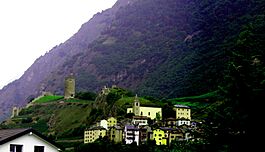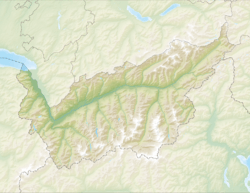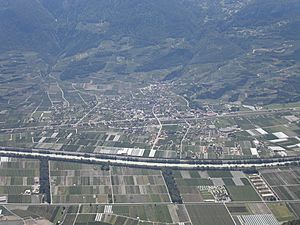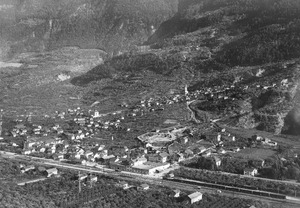Saxon, Switzerland facts for kids
Quick facts for kids
Saxon
|
||
|---|---|---|

Saxon tower, above the village
|
||
|
||
| Country | Switzerland | |
| Canton | Valais | |
| District | Martigny | |
| Area | ||
| • Total | 23.22 km2 (8.97 sq mi) | |
| Elevation | 533 m (1,749 ft) | |
| Population
(Dec 2020 )
|
||
| • Total | 6,278 | |
| • Density | 270.37/km2 (700.26/sq mi) | |
| Postal code |
1907
|
|
| Surrounded by | Bagnes, Charrat, Fully, Riddes, Saillon, Vollèges | |
| Twin towns | Bouliac (France) | |
Saxon is a small town, also called a municipality, located in the Martigny district. It is part of the canton of Valais in Switzerland.
Contents
History of Saxon
Saxon was first mentioned in old records in the year 1153. Back then, it was called de Saxone.
Geography of Saxon
Saxon covers an area of about 23.2 square kilometers (9 square miles). A large part of this land, about 31.9%, is used for farming. Forests cover about 50.6% of the area.
About 9.3% of the land has buildings or roads. The remaining 8.1% is land that cannot be used for building or farming.
The town is located in the Martigny district. It sits along the left bank of the Rhone River. Saxon stretches from the Pierre-à-Voir mountain, which is 2,476 meters (8,123 feet) high, down to the Rhone River. The municipality includes the main villages of Saxon and Gottefrey, along with a few smaller hamlets.
Saxon's Coat of Arms
The official symbol, or coat of arms, of Saxon is described as: Gules a trefoil branch Argent. This means it has a red background with a silver clover-like plant design.
People and Population
Saxon has a population of about 4,338 people (as of 2022). In 2008, about 28.8% of the people living in Saxon were foreign nationals. Over ten years, from 2000 to 2010, the population grew by nearly 30%. Most of this growth was due to people moving into the area.
Languages Spoken
Most people in Saxon speak French as their main language. In 2000, about 85.9% of the population spoke French. The second most common language was Portuguese, spoken by 4.6% of residents. Albanian was the third most common, spoken by 3.4%. A smaller number of people spoke German or Italian.
Where People Come From
In 2000, about 43.5% of the people living in Saxon were born there. Another 23.6% were born in the same canton (Valais). About 10% were born elsewhere in Switzerland. The remaining 21.6% were born outside of Switzerland.
Age Groups
In 2000, children and teenagers (ages 0-19) made up 23.4% of Saxon's population. Adults (ages 20-64) were the largest group, at 60.2%. Seniors (over 64 years old) made up 16.5% of the population.
Homes and Households
In 2000, there were 1,359 private homes in Saxon. On average, each home had 2.4 people living in it. About 73.4% of the homes were lived in all year round. Some homes were used only during certain seasons, and a small number were empty.
Population Changes Over Time
The chart below shows how Saxon's population has changed over many years:

Economy and Jobs
In 2010, Saxon had an unemployment rate of 9.7%. This means about 9.7% of people who wanted to work could not find a job.
Types of Jobs
In 2008, there were many different types of jobs in Saxon:
- Primary Sector: This includes jobs like farming. About 225 people worked in this sector.
- Secondary Sector: This includes jobs in factories, mining, and construction. About 229 people worked here. Most of these jobs were in construction.
- Tertiary Sector: This includes jobs in services, like shops, restaurants, and healthcare. About 734 people worked in this sector.
Many people who live in Saxon travel to other towns for work. In 2000, about 878 people left Saxon to work elsewhere, while 406 people came into Saxon for work. Most people (69.2%) used a private car to get to work, while 9.8% used public transportation.
Religion in Saxon
According to the 2000 census, most people in Saxon were Roman Catholic, making up about 77.8% of the population. About 6.8% belonged to the Swiss Reformed Church.
There were also smaller groups of people who were Orthodox Christian, Christian Catholic, or belonged to other Christian churches. A small number of people were Islamic. Some people did not belong to any church, or were agnostic or atheist.
Education in Saxon
In Saxon, many people have completed higher levels of education. In 2000, about 30.4% of the population had finished upper secondary education. This is like high school. Another 6.6% had completed even higher education, such as university or a specialized college.
Saxon has a community and school library called Bibliothèque communale et scolaire. In 2008, this library had over 11,000 books and other media. It loaned out more than 16,000 items that year. The library was open for 132 days a year, for about 19 hours each week.
See also
 In Spanish: Saxon (Valais) para niños
In Spanish: Saxon (Valais) para niños






